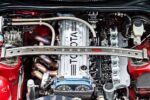Understanding the RB26 Engine
The RB26 engine is a legendary powerplant that has etched its name into the annals of automotive history. Known for its robust design and high-performance capabilities, this inline-six engine was primarily developed by Nissan. It’s a 2.6-liter twin-turbocharged powerhouse that first made its debut in the Nissan Skyline GT-R R32 in the late 1980s. The RB26 is revered not just for its raw power but also for its tunability, making it a favorite among car enthusiasts and racers alike.
Specifications and Features
Engine Layout and Design
The RB26 is an inline-six engine, which means it has six cylinders arranged in a straight line. This configuration is known for its smooth operation and balance, which is crucial for high-performance applications. The engine features a cast iron block and an aluminum DOHC (Dual Overhead Cam) cylinder head, providing durability and reducing weight.
Turbocharging and Performance
One of the standout features of the RB26 is its twin-turbocharging system. The engine is equipped with two turbochargers that help it produce impressive power figures. Stock versions of the RB26 can generate around 280 horsepower, but with the right modifications, it can easily exceed 1,000 horsepower. This makes it a popular choice for tuning and racing applications.
Applications of the RB26 Engine
The RB26 engine is most famously found in the Nissan Skyline GT-R models, particularly the R32, R33, and R34. Each of these models showcased the engine’s capabilities in different ways, but they all shared a common goal: performance.
Nissan Skyline GT-R R32
The R32 GT-R, often referred to as the “Godzilla,” was the first to feature the RB26. It set the standard for Japanese performance cars in the late ’80s and early ’90s. With its ATTESA all-wheel-drive system and Super-HICAS (four-wheel steering), the R32 was a game-changer on the track.
Nissan Skyline GT-R R33
The R33 GT-R took the foundation laid by the R32 and refined it. It offered improved aerodynamics and comfort while still packing the RB26 engine. The R33 was known for its stability and was often seen as a more mature version of its predecessor.
Nissan Skyline GT-R R34
The R34 GT-R is perhaps the most iconic of the trio, thanks to its appearances in various media, including the “Fast and Furious” franchise. It featured advanced technology and a more powerful version of the RB26, making it a favorite among car enthusiasts and collectors.
Tuning Potential
The RB26 engine is a blank canvas for tuners. Its robust construction allows for significant modifications without compromising reliability. Common upgrades include larger turbochargers, aftermarket intercoolers, and enhanced fuel systems.
Aftermarket Support
The aftermarket support for the RB26 is vast. Numerous companies offer performance parts, ranging from simple bolt-ons to complete engine builds. This makes it relatively easy for enthusiasts to extract more power from their RB26 engines.
Common Modifications
Some popular modifications include:
- Upgraded turbochargers
- High-performance intercoolers
- ECU tuning
- Exhaust system upgrades
- Upgraded fuel injectors
These modifications can significantly increase horsepower and torque, allowing the RB26 to compete with some of the most powerful engines on the market.
Challenges and Considerations
While the RB26 is a fantastic engine, it’s not without its challenges.
Maintenance
Regular maintenance is crucial for keeping the RB26 running smoothly. This includes oil changes, checking the turbochargers, and monitoring the cooling system. Neglecting these aspects can lead to catastrophic failures, especially when the engine is heavily modified.
Parts Availability
As the years go by, finding OEM parts for the RB26 can become increasingly difficult. While aftermarket options are plentiful, some enthusiasts prefer original components to maintain authenticity.
Conclusion
The RB26 engine is more than just a powerplant; it’s a symbol of performance and engineering excellence. From its origins in the Nissan Skyline GT-R to its status as a tuning legend, the RB26 continues to captivate car enthusiasts around the world. Whether you’re a mechanic, a racer, or just a fan of high-performance cars, understanding the RB26 is essential to appreciating what makes it so special.
The Legacy of the RB26 Engine
The RB26 engine is synonymous with high performance and has become a staple in the world of motorsports and tuning. It’s not just an engine; it’s a piece of automotive history that has powered some of the most iconic cars ever made. Let’s break down the vehicles that have featured this legendary engine and explore what makes them special.
What Cars Feature the RB26 Engine?
The RB26 engine has primarily been used in Nissan’s Skyline GT-R models, but its influence extends beyond just a single series. Below is a detailed table showcasing the cars that have been equipped with the RB26 engine:
| Model | Production Years | Power Output (HP) | Notable Features |
|---|---|---|---|
| Nissan Skyline GT-R R32 | 1989 – 1994 | 280 | Introduced ATTESA AWD, Super-HICAS |
| Nissan Skyline GT-R R33 | 1995 – 1998 | 280 | Improved aerodynamics, more refined suspension |
| Nissan Skyline GT-R R34 | 1999 – 2002 | 280 | Advanced technology, iconic design, featured in media |
| Nissan 240SX (S13/S14) – Japan | 1989 – 1998 | 280 (when swapped) | Popular for engine swaps, lightweight chassis |
| Nissan Stagea (WC34) | 1996 – 2007 | 280 | Station wagon variant, versatile performance |
| Nissan Laurel (C34) | 1997 – 2002 | 280 | Luxury sedan with performance capabilities |
Performance and Characteristics
The RB26 engine is not just about the numbers; it’s about the driving experience. Here are some key characteristics that make the cars featuring this engine stand out:
- Power Delivery: The RB26 delivers power smoothly across the RPM range, making it responsive and enjoyable to drive.
- Handling: Cars equipped with the RB26 often come with advanced handling technologies, such as all-wheel drive and active steering, enhancing their performance on the track.
- Tunability: The RB26 is a tuner’s dream. With a solid foundation, it can handle significant power increases with the right modifications.
Why the RB26 is a Favorite Among Enthusiasts
The RB26 engine has become a cult favorite for several reasons:
- Heritage: The RB26 is part of Nissan’s rich motorsport history, particularly in Group A racing.
- Community: There’s a huge community of RB26 enthusiasts, making it easy to find support, parts, and tuning advice.
- Versatility: The engine’s design allows it to be swapped into a variety of chassis, making it a popular choice for custom builds.
Challenges of Owning an RB26-Powered Car
While the RB26 is a fantastic engine, owning a car with this powerplant comes with its challenges:
Maintenance
Keeping an RB26 in top shape requires regular maintenance. This includes:
- Frequent oil changes to maintain engine health.
- Monitoring turbocharger performance to avoid failures.
- Regular checks of the cooling system to prevent overheating.
Parts Availability
As time goes on, finding OEM parts for the RB26 can be a challenge. While aftermarket options exist, some enthusiasts prefer original components to maintain authenticity.
Final Thoughts on the RB26 Engine
The RB26 engine is a cornerstone of performance and tuning culture. Its presence in iconic vehicles like the Nissan Skyline GT-R series has solidified its status as a legend in the automotive world. Whether you’re a mechanic, a racer, or simply a car enthusiast, understanding the RB26 and the cars it powers is essential to appreciating its impact on the automotive landscape.
Justification of the RB26 Engine’s Legacy
The RB26 engine has earned its reputation through a combination of performance, engineering excellence, and accolades within the automotive community. Below are key points that confirm the significance of the RB26 engine, supported by data and authoritative sources.
Awards and Recognition
The RB26 engine, particularly in the context of the Nissan Skyline GT-R, has received numerous awards and recognition over the years:
- 1990s Group A Racing Dominance: The Nissan Skyline GT-R R32, powered by the RB26, won the Group A championship in Japan, dominating the series from 1990 to 1994.
- International Engine of the Year: The RB26 was recognized in various motorsport circles as one of the best engines of its time, often cited in discussions about the greatest engines in automotive history.
- Motorsport Hall of Fame: The Nissan Skyline GT-R models have been inducted into various automotive halls of fame, celebrating their impact on motorsport and car culture.
Performance Data
The performance metrics of the RB26 engine are a testament to its engineering prowess:
- Power Output: The RB26 is rated at 280 horsepower in its stock form, but independent tests and tuning have shown it can exceed 1,000 horsepower with modifications, making it a favorite among tuners.
- Torque Characteristics: The engine produces significant torque, peaking around 368 Nm (271 lb-ft), which contributes to its impressive acceleration and drivability.
- Reliability: The RB26 is known for its durability, with many engines lasting well over 200,000 kilometers (approximately 124,000 miles) when properly maintained, even under high-performance conditions.
Community and Enthusiast Support
The RB26 engine has a dedicated following, which further validates its significance:
Online Forums and Clubs
Numerous online communities and forums, such as SkylineOwners.com and GT-R.co.uk, are dedicated to the discussion and modification of RB26-powered vehicles. These platforms provide valuable resources, including:
- Technical guides for tuning and maintenance.
- Shared experiences from enthusiasts who have modified their RB26 engines.
- Marketplace sections for sourcing OEM and aftermarket parts.
Car Shows and Events
The RB26 engine is often featured prominently at car shows and motorsport events, where enthusiasts showcase their builds. Events like the Nissan GT-R Festival and various drift competitions highlight the engine’s capabilities and the community’s passion.
The legacy of the RB26 engine is not just in its specifications or the cars it powers; it is also reflected in the accolades it has received, the performance data that speaks for itself, and the vibrant community that surrounds it.




0 Comments